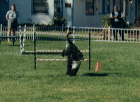Exercising your Portuguese Water Dog
incorporating CLICKER training
 Ever heard of clicker training? I was brought up using the traditional methods of training. I could never understand why my dogs really didn't like training (I didn't either for that matter). Trainers advised me mostly that I had to be tougher with my dogs. I moved from one training school to the next in a vain attempt to find a methodology I liked. At that stage, nobody I knew, including myself had even heard about clicker training. This was in mid-1996, on the East Coast of Australia.
Ever heard of clicker training? I was brought up using the traditional methods of training. I could never understand why my dogs really didn't like training (I didn't either for that matter). Trainers advised me mostly that I had to be tougher with my dogs. I moved from one training school to the next in a vain attempt to find a methodology I liked. At that stage, nobody I knew, including myself had even heard about clicker training. This was in mid-1996, on the East Coast of Australia.
In 1997, I gained internet access, and a new world opened up to me. It was then I discovered clicker training. For those of you who have never heard about clicker training, it is a no stress way of training, involving no physical force or punishment, producing results where the both you and the animal, want to work and have fun.
There are a lot of pages on the web that go into a lot of depth on clicker training. Try going to the guru herself, Karen Pryor, or the wonderful pages of Gary Wilkes. I also recommend strongly that you join the clicker email list. For lots and lots of good clicker info try the clicker keeper's page. It offers lots of valuable tips to solve different training problems. One of the most comprehensive pages I have come across can be found when you
click here. It goes into a lot of the theory of operant and classical condition. This site is definitely worth a look.
My answers to some behavioural problems
This is a new section in which I list my responses to people's questions about behavioural problems. Please note, I am not an behavioural expert (well not with dogs, I but I have a Masters degree in Human Resources!). And I don't have experience in treating every behavioural problem in a dog. No, this section deals directly with problems that I have dealt with successfully.
As time progresses, I will set up a separate page for these.
Dear Jane, my boxer keeps bolting away from us. He won't come when he's called, and every time the front door is opened he makes for an escape. What can I do?
You are facing a common problem unfortunately. When I grew up we had a King Charles Spaniel that did exactly the same thing. So when I got my dogs this is what I did:
1. every time they came to me while I was at home, they got lots of lavish praise and a treat. So that they knew coming to mum was a good thing
2. when they came when they were called, they also got treats and praise. So coming to mum when she called was a good thing.
3. I would take them out the front which was not fenced, and get them used to be untethered and not running away. This was done in small amounts first, and then in bigger time slots. I made it a better option to stay with me, than to go off exploring.
4. When I took them for walks, I would allow them free time off leash to explore, but within an area that was safe, and I could more or less easily retrieve them
5. If they didn't come when called, I went and got them, but never ever punished them for not coming (no matter how angry I was!).
With your boy, I would start inside first with him. Have two people sit 5 meters apart with a lot of treats in their hands. Call him to each of you and when he comes, say "yes!" and treat him. Get him running back and forwards between you. Make it a game. Make it fun. Of course, it would be easier with a clicker, but using your voice as a "yes" will suffice at this stage. Do if for five minutes, three times a day. Then start adding distractions. If he runs to the distraction that's ok, but just ignore him for a few seconds when he comes back. Then start the game again. Soon he will realise that it's a great thing to come when he's called. Start doing it with the front door open when you feel happy with his progress. Make sure you have someone ready to shut it if he bolts for it. But work on this daily, until he can play the game while the front door is open. If/when he makes a bolt for it, close the door, and ignore him for a few minutes. Then play the game again. It will help if he is hungry too before you start playing the game.
Take him to the park and put him on a long leash. Then play the game again. Take it slowly. As he gets better, move him to an outside fenced area off lead. And start adding distractions.
The clicker is a wonderful tool to use here as it will help your boy understand exactly when he has done the right thing (provided your timing is good). Let me know how you go.
There are some excellent books available. I suggest that you get your hands on a couple of books and some videos. They will provide some excellent reference advice. Try the Amazon link below to find the best value on clicker books:
Please note, all Bluegrace puppy buyers will receive a clicker training book and pack of clickers with their pup. I will have already started them with the clicker (from four weeks of age), and the pup will have already learned some basic commands.
 The Portuguese Water Dog is a working dog. As such, while she will more than enjoy your favourite couch, she does need daily exercise. This may take the form of a run along with you, or a game of frisbee, or a long stroll through the park. Your PWD, or any other breed for that matter, will revel in clicker training.
The Portuguese Water Dog is a working dog. As such, while she will more than enjoy your favourite couch, she does need daily exercise. This may take the form of a run along with you, or a game of frisbee, or a long stroll through the park. Your PWD, or any other breed for that matter, will revel in clicker training.
 Your PWD is not a spectator dog. No, she wants to be involved in everything you do. Indeed, that's what attracts a lot of people to the breed. Whether this is a game of ball, or playing football with the families, or helping you dig in the garden, you will just about always find your PWD an active participant.
Your PWD is not a spectator dog. No, she wants to be involved in everything you do. Indeed, that's what attracts a lot of people to the breed. Whether this is a game of ball, or playing football with the families, or helping you dig in the garden, you will just about always find your PWD an active participant.
Be sure that if you want to bring a PWD into your family, that you can provide the exercise - both mental and physical - that they require.
The PWD is a natural herder and retreiver. She thrives on activities, and has fantastic potential as an agility dog, water worker, and obedience dog.
Read the story of Sheba, and how she overcame a lot of obstacles to not only become a PWD service dog, but also achieved great success as an agility dog and water trial dog.
 A point to note is that the middle name of the PWD is "water". Hence, most are particularly inclined towards water, while some may need a bit more encouragement. The clicker approach is perfect for water work.
A point to note is that the middle name of the PWD is "water". Hence, most are particularly inclined towards water, while some may need a bit more encouragement. The clicker approach is perfect for water work.
This picture is from the US PWD Speciality Water Trials. On a cool Autumn morning, participants were out early competing more against themselves, rather than each other.
Please, if you have any questions, email us.


More Bluegrace Surfing?
Main Page /
Home of Bluegrace /
Health Information /
Diet /
Selection /
Home of Bluegrace/
PWD's in Australia /
Grooming /
Temperament /
History
 - Bluegrace Surfers to this site since 27th May, 1998.
- Bluegrace Surfers to this site since 27th May, 1998.
This page hosted by
 Get your own Free Home Page
Get your own Free Home Page
 Ever heard of clicker training? I was brought up using the traditional methods of training. I could never understand why my dogs really didn't like training (I didn't either for that matter). Trainers advised me mostly that I had to be tougher with my dogs. I moved from one training school to the next in a vain attempt to find a methodology I liked. At that stage, nobody I knew, including myself had even heard about clicker training. This was in mid-1996, on the East Coast of Australia.
Ever heard of clicker training? I was brought up using the traditional methods of training. I could never understand why my dogs really didn't like training (I didn't either for that matter). Trainers advised me mostly that I had to be tougher with my dogs. I moved from one training school to the next in a vain attempt to find a methodology I liked. At that stage, nobody I knew, including myself had even heard about clicker training. This was in mid-1996, on the East Coast of Australia. 

 Your PWD is not a spectator dog. No, she wants to be involved in everything you do. Indeed, that's what attracts a lot of people to the breed. Whether this is a game of ball, or playing football with the families, or helping you dig in the garden, you will just about always find your PWD an active participant.
Your PWD is not a spectator dog. No, she wants to be involved in everything you do. Indeed, that's what attracts a lot of people to the breed. Whether this is a game of ball, or playing football with the families, or helping you dig in the garden, you will just about always find your PWD an active participant. A point to note is that the middle name of the PWD is "water". Hence, most are particularly inclined towards water, while some may need a bit more encouragement. The clicker approach is perfect for water work.
A point to note is that the middle name of the PWD is "water". Hence, most are particularly inclined towards water, while some may need a bit more encouragement. The clicker approach is perfect for water work. 
